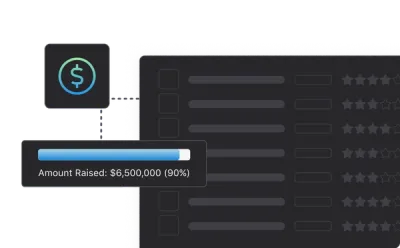
Cap Table: What It Is, Why It’s Essential for Startups, and How to Create One

A well-maintained cap table is one of the most critical tools for startup founders navigating the complex world of equity and ownership. As a startup grows, managing and understanding equity distribution becomes essential for making informed decisions, attracting investors, and maintaining transparency. A clear cap table can help founders visualize ownership, anticipate dilution, and ensure accurate fundraising. Whether you’re preparing for investment rounds, employee stock options, or future exits, having a reliable cap table is crucial for your startup’s financial health and long-term success.

What Is a Cap Table (i.e., Capitalization Table)?
A cap table, or capitalization table, is a detailed spreadsheet or document that outlines a startup's equity ownership. It provides a breakdown of all the company’s securities, including common and preferred shares, options, warrants, and convertible instruments. Each entry typically includes details such as the type of security, the number of shares issued, the names of shareholders or stakeholders, and their ownership percentage.
Cap tables also help illustrate how ownership evolves over time, especially after significant events like fundraising rounds, employee stock option grants, or equity transfers. A comprehensive cap table allows founders, investors, and employees to understand who owns what portion of the company and how that ownership could be diluted in future scenarios.
Related resource: Emerging Fund Managers You Want on Your Cap Table
What Is the Difference Between a Cap Table and a Term Sheet?
While both a cap table and a term sheet play crucial roles in a startup’s equity management and fundraising, they serve distinct functions and provide different types of information.
- Cap Table:A cap table is a current snapshot of a company’s ownership structure. It details all the securities issued, such as shares, options, warrants, and convertible notes, and specifies who owns them. The cap table evolves with each new investment, equity issuance, or employee stock grant. It helps founders and investors understand who owns what percentage of the company, track dilution, and plan for future fundraising.
- Term Sheet:A term sheet is a forward-looking proposal provided by an investor during a funding round. It outlines the terms and conditions of a potential investment, such as the amount of capital being invested, the company’s valuation, equity percentage, liquidation preferences, voting rights, and other key terms. A term sheet is non-binding (except for certain confidentiality or exclusivity clauses) and serves as the basis for negotiating and drafting the final investment agreement.
In summary:
- The cap table is a snapshot of the company’s current equity structure.
- The term sheet sets the groundwork for future changes to the cap table based on agreed-upon investment terms.
Both documents are critical during fundraising, but they address different aspects of the process- one tracks equity, and the other negotiates terms.
Related resources:
Why Is a Cap Table Important for Startups?
A cap table is essential for maintaining transparency, managing equity, and making informed business decisions as your startup scales. It provides a clear view of who owns what, how ownership changes over time, and the potential impact of future investments or stock option grants. For founders, a cap table helps protect against excessive dilution and ensures strategic equity allocation. It offers investors insight into the company’s ownership structure and potential risks. Without an accurate and up-to-date cap table, startups can face challenges during fundraising, audits, or key financial decisions, making it a foundational tool for growth and sustainability.
Understanding the Ownership Breakdown of Founders, Investors, and Employees
Founders must always be aware of what their cap table means for ownership of their company. Understanding ownership is critical as the company grows and develops. Cap tables tell investors who owns what part of a company. Current investors want to see who has control. They also want the ability to forecast potential payouts and dilution under specific scenarios based on the ownership split. The breakdown of ownership in a startup can affect the company's overall value for future fundraising rounds, as well as who needs to be at the table for certain critical company decisions.
Related Resources:
- How to Fairly Split Startup Equity with Founders
- Understanding Contributed Equity: A Key to Startup Financing
Monitoring Equity Value and Tracking Company Valuation
Monitoring equity value and tracking company valuation are crucial for both employees and investors. An up-to-date cap table provides a transparent view of how much the company is worth and how each stakeholder’s equity is affected by funding rounds, option grants, or changes in ownership.
A well-maintained cap table helps all stakeholders understand how ownership changes, ensuring alignment and confidence in the company’s growth trajectory. By consistently monitoring equity value, startups can facilitate fair and transparent equity management, essential for long-term success.
- For Employees: Employees who hold equity, such as stock options, need to understand the potential value of their shares. A detailed cap table helps them see how their ownership stake evolves over time, providing clarity on the potential value of their equity and how it may be diluted with new investments. This transparency can also increase motivation and align their interests with the company’s growth.
- For Investors: Investors rely on the cap table to evaluate their ownership percentage, potential returns, and dilution risk. By tracking the company’s valuation over time, investors can assess whether their investment is growing in value and determine how future funding rounds will impact their stake. Accurate valuation data also informs strategic decisions during follow-on investments or exit planning.
Facilitating Fundraising Rounds with Transparency and Accuracy
In addition to current investors utilizing a cap table for forecasting and dilution predictions for different investment outcomes, potential investors and future fundraising can also be affected by cap tables. By viewing a cap table, potential investors can evaluate how much control and leverage could be maintained during negotiations. Historical insight provided in a cap table can affect negotiating current valuation for new funding raises. Additionally, an existing shareholder can easily determine what percentage of the company to give to the new investors in exchange for the capital contributed.

Preparing for Financial Audits and Regulatory Compliance
Maintaining an accurate and up-to-date cap table is essential for startups to ensure compliance with legal and regulatory requirements. Regulatory authorities and auditors often require companies to present their cap tables annually, ensuring adherence to legal standards and facilitating processes such as capital rounds and ownership changes.
A well-maintained cap table provides a transparent record of the company's equity structure, which is crucial for:
- Regulatory Filings: Accurate cap tables are necessary for filings with regulatory bodies, such as the Securities and Exchange Commission (SEC), to comply with securities laws and regulations.
- Tax Reporting: Proper documentation of equity ownership and transactions ensures compliance with tax obligations and helps avoid penalties and legal issues.
- Investor Relations: Transparency in equity distribution builds trust with investors, demonstrating responsible management and adherence to legal standards.
Why Do Investors Want to See the Cap Table?
Investors want to review a startup’s cap table because it offers a comprehensive snapshot of the company’s ownership structure. This transparency is crucial for assessing risk, understanding equity dynamics, and making informed investment decisions. A well-maintained cap table helps investors evaluate several key aspects:
- Equity Distribution: Investors can see how ownership is split between founders, employees, and previous investors. This helps them gauge how much control the founding team retains and identify any potential risks related to future decision-making authority.
- Dilution Risk: The cap table reveals how new investments might dilute existing ownership. Investors need to understand how their stake may change in future funding rounds and whether the current equity structure leaves room for sustainable growth.
- Investor Rights and Preferences: A detailed cap table shows who holds preferred shares, warrants, or convertible instruments. This helps investors understand potential liquidation preferences and voting rights, which can affect exit strategies and return on investment.
- Potential Red Flags: A cap table can highlight any irregularities, such as over-diluted founders or complicated equity structures that might hinder future fundraising.
What Does a Cap Table Look Like?
A cap table typically takes the form of a spreadsheet or specialized software-generated table that organizes the company's equity information clearly and structured. It generally includes stakeholders in rows and types of equity details in columns, making it easy to see who owns what and how much. For more complex startups, the cap table can include additional details like option pools, convertible notes, and transaction history.
Key components of a cap table often include:
- Shareholder Names: Lists founders, employees, investors, and other stakeholders who hold equity in the company.
- Number of Shares: The total number of shares each stakeholder owns.
- Type of Security: Categories like common shares, preferred shares, stock options, warrants, or convertible instruments.
- Ownership Percentage: Each stakeholder's proportional ownership of the company based on their share count.
- Investment Date: The date each stakeholder acquired their shares or invested in the company.
- Valuation Details: Information on the price per share and company valuation at each investment round.

Does a Cap Table Show Debt?
A cap table does not typically show debt. Rather, it is specifically designed to track a company's equity ownership structure, detailing shares, options, warrants, and other equity instruments. Its primary function is to outline who owns portions of the company and how ownership is distributed among stakeholders like founders, employees, and investors.
However, while debt is not shown on a cap table, certain debt-related instruments might be included if they have the potential to convert into equity. For example:
- Convertible Notes: These are debt instruments that convert into equity at a later stage, often during a future funding round. Convertible notes are generally tracked on the cap table because they will eventually affect ownership percentages once converted.
- SAFEs (Simple Agreements for Future Equity): Similar to convertible notes, SAFEs are agreements where investors provide funding in exchange for the right to future equity, and they typically appear on the cap table before conversion.
Traditional loans or other forms of debt (e.g., bank loans, lines of credit) are tracked separately in the company’s financial statements, such as balance sheets, rather than on the cap table. This separation helps maintain clarity between the company’s equity structure and its liabilities.
Related resources:
- The Startup's Handbook to SAFE: Simplifying Future Equity Agreements
- SAFE Fundraising: When to Consider & Benefits
Information to Include in a Cap Table
There is no fixed format for a cap table, but a comprehensive cap table should include key components that provide a clear picture of the company's equity structure. These components ensure transparency for founders, investors, and employees, helping to avoid misunderstandings and potential errors during fundraising, audits, and strategic planning. Here are the essential elements to include:
- Shareholders and Stakeholders: A list of all individuals and entities that hold equity in the company, including founders, employees, angel investors, venture capital firms, and advisors. This helps identify who owns portions of the company and their respective roles.
- Equity Details: Information on the type of equity held, such as common shares, preferred shares, stock options, warrants, and restricted stock units (RSUs). Each entry should specify the number of shares issued and any associated terms.
- Valuation and Ownership: Details on the company's valuation at different stages (e.g., pre-money and post-money valuations) and the percentage of ownership each stakeholder holds. This helps illustrate how equity is distributed and how ownership changes with new investments.
- Option Pool: The number of shares allocated for current and future employees as part of an equity incentive plan. The option pool is important for understanding potential dilution and planning for new hires.
Related resource: The Essential Guide to Option Pools: Definition, Purposes, and Benefits for Startups
- Convertible Instruments: Any convertible notes, SAFEs (Simple Agreements for Future Equity), or other instruments that may convert into equity in the future. These should include details such as the conversion terms, amounts, and potential dilution impact.
- Transaction History: A record of all equity-related transactions, including issuance dates, purchase prices, investment rounds, and transfers. This historical data is crucial for maintaining accuracy and demonstrating compliance during audits.
- Restrictions and Agreements: Information on any restrictions or agreements related to equity, such as vesting schedules, buyback rights, or shareholder agreements. This helps stakeholders understand the conditions attached to their equity and any limitations on transferring shares.
How Do You Make a Cap Table?
Cap tables can be created and managed in a variety of ways. Typically, it is common for new startup founders to build their initial cap table in a spreadsheet. However, as your startup grows and the valuation and stakeholders get more involved and complex, a simple cap table design in a program like Excel won’t work.
Some companies will use tools like CapShare or Carta, to build and manage their cap tables. These tools are typically more dynamic and less manual than managing via Excel. They can be easier to utilize to share out and circulate with employees and investors.
In other scenarios, it might make the most sense to outsource the production and management of a cap table. When founders choose to self-manage their own cap table, they are susceptible to risks. Some of these risks include miscalculating valuations, which can lead to giving up too much equity and over-diluting shares in new investment rounds. Additionally, there might be tax consequences or legal issues arising from the mismanagement of a cap table. By outsourcing the production and management of a cap table. Typically, this management is outsourced to a legal team to ensure accuracy and compliance. Outsourcing is more expensive than managing with a software but can be much less expensive at the cost of major mistakes or miscalculation of value.

How to Use a Cap Table?
When using a cap table, it’s important to understand the following formulas:
- Post-Money Valuation = Pre-Money Valuation + Total Investment Amount
- Price-Per-Share = Pre-Money Valuation / Pre-Money Shares
- Post-Money Shares = Post Money Valuation/ Price-Per-Share
- Investor Percent Ownership = Investor Shares / Post-Money Shares
These formulas are essentially what will be laid out in a cap table so understanding them is crucial. These formulas can also be used to update the cap table as it grows more complex via different significant financial rounds.
The more investment rounds or other significant financial changes on the table, the more complex the cap table gets. This breakdown essentially showcases the additional steps and participants who are stakeholders in the startup.
- Founders round – this is the simplest version of the cap table and will typically showcase the simple split of equity between the founders of the company.
- Seed round – this introduces investors to the table who now own a portion of the company along with the founders and have given cash to the startup altering the overall value.
- Options pool round – when options are provided for new employees, this changes the value and breakdown of the company as represented by the cap table. Overtime, as more employees are hired and more options are granted, the more complex the cap table gets.
- VC round(s) – With any additional funding rounds taken on by the startup, the valuation drastically changes as does the list of stakeholders on the cap table.
All of these events or rounds are significant and will change the breakdown and complexity of the cap table.
How Do You Keep a Cap Table Updated?
With the array of cap table management tools on the market, updating and keeping tabs on your cap table is easier than ever before. Generally, founders need to stay on top of their cap table management. If you raise a new round, offer new employee grants, terminate an employee, etc., you need to make the changes as soon as possible to avoid future headaches.
If you put off updating your cap table in real-time, it could end up being a costly mistake as you need a lawyer to update and correct the table.
To make your life as easy as possible, we recommend using software to manage and update your cap table. There are countless options, but we recommend Pulley. You can learn more about cap table management (and Pulley) in our Founders Forward Podcast with Pulley CEO and Founder Yin Wu here.
Cap Table Examples/Templates
Instead of starting from scratch, many founders will use a template to build out a cap table. Check out these templates below:
1. S3 Ventures Template
S3 Ventures offers a template in Excel that they recommend for their portfolio companies.

2. Eqvista Template
Eqvista's template includes ownership structure and the capital committed.

3. Cap Board Template
Cap Board's template is a basic cap table on Google Spreadsheet, with formulas included, that can be used for any early-stage startup.

4. CFI Template
CFI’s has many free excel templates. The spreadsheet below contains two sections – valuation and ownership. All numbers in blue are hard-coded assumptions and all numbers in black are formulas.

Manage Your Stakeholders Effectively with Visible

Effectively managing your cap table is essential for maintaining transparency, building investor confidence, and making informed decisions. With Visible, you can streamline your stakeholder communication by centralizing key data, sharing investor updates, and tracking interactions- all in one platform. Visible makes it easy to keep investors informed and engaged while helping you stay organized and focused on growth.
Ready to simplify stakeholder management? Give it a free try for 14 days here.



